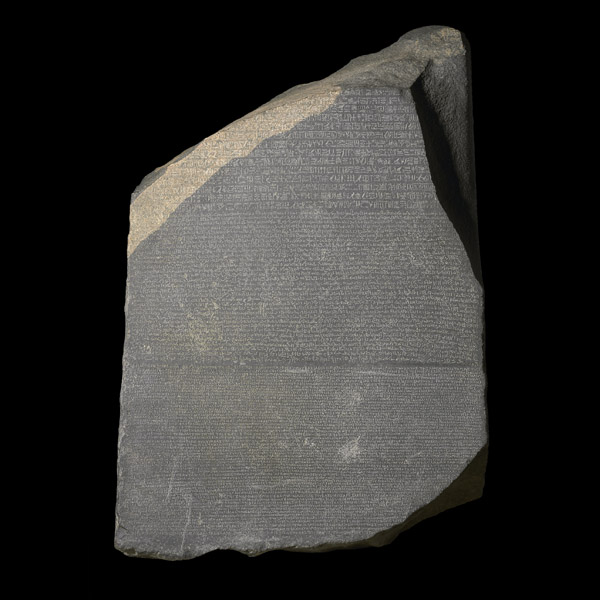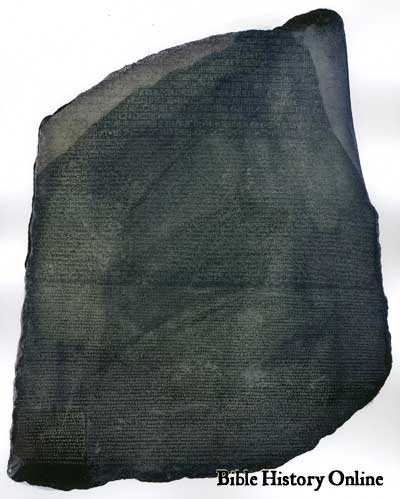Rosetta Stone
Was this stone the key to deciphering the hieroglyphs of ancient Egypt?This black basalt stone slab was found in 1798 by French soldiers in the rubble of a wall near the Egyptian town of Rosetta. The writing on it appeared very ancient, at the top of the stone were hieroglyphs reading right to left. In the middle there was shorthand demotic script, and at the bottom was Greek reading left to right. The soldiers realized that it might be an important discovery and they brought it to their authorities. Napoleon Bonaparte became immediately interested in the stone and he had ink impressions made and sent to scholars in Europe. No one understood the meaning of the inscriptions on the Rosetta Stone until French scholar Jean Francois Champollion. He spent a good portion of his life studying the hieroglyphs of ancient Egypt and the Rosetta Stone. He finally solved the mystery in 1822 when he deciphered the text by matching the name of Ptolemy in the Greek with a hieroglyph found on an ancient Egyptian ring with a stamp which bore the name of Ptolemy. He did the same with the royal name Cleopatra which was from a cartouche of Cleopatra found on an obelisk from Philae. Champollion determined the phonetic values of the inscriptions and of the signs.
Ezekiel 20:5 - And say unto them, Thus saith the Lord GOD; In the day when I chose Israel, and lifted up mine hand unto the seed of the house of Jacob, and made myself known unto them in the land of Egypt, when I lifted up mine hand unto them, saying, I [am] the LORD your God;
"And all the people brake off the golden earrings which were in their ears, and brought them unto Aaron. And he received them at their hand, and fashioned it with a graving tool, after he had made it a molten calf: and they said, These be thy gods, O Israel, which brought thee up out of the land of Egypt." - Exodus 32:3,4The discovery of the Rosetta Stone is important in the study of Biblical Archaeology, it ushered in the era of modern Egyptology and opened our eyes to 3000 years of peculiar pictures inscribed on Egyptian temples, statues, and monuments, and a wealth of information verifying and never contradicting the Scriptures.
Also see: Amazing Facts about the Discovery of the Rosetta Stone
British Museum Excerpt
The Rosetta Stone
Height: 114.400 cm (max.)
Width: 72.300 cm
Thickness: 27.900 cm
Excavated by Pierre Fran�ois Xavier Bouchard
Gift of George III
EA 24
Room 4: Egyptian sculpture
From Fort St Julien, el-Rashid (Rosetta), Egypt
Ptolemaic Period, 196 BC
Valuable key to the decipherment of hieroglyphs
The inscription on the Rosetta Stone is a decree passed by a council of
priests, one of a series that affirm the royal cult of the 13-year-old
Ptolemy V on the first anniversary of his coronation.
In previous years the family of the Ptolemies had lost control of certain
parts of the country. It had taken their armies some time to put down
opposition in the Delta, and parts of southern Upper Egypt, particularly
Thebes, were not yet back under the government's control.
Before the Ptolemaic era (that is before about 332 BC), decrees in
hieroglyphs such as this were usually set up by the king. It shows how much
things had changed from Pharaonic times that the priests, the only people
who had kept the knowledge of writing hieroglyphs, were now issuing such
decrees. The list of good deeds done by the king for the temples hints at
the way in which the support of the priests was ensured.
The decree is inscribed on the stone three times, in hieroglyphic (suitable
for a priestly decree), demotic (the native script used for daily purposes),
and Greek (the language of the administration). The importance of this to
Egyptology is immense. Soon after the end of the fourth century AD, when
hieroglyphs had gone out of use, the knowledge of how to read and write them
disappeared. In the early years of the nineteenth century, some 1400 years
later, scholars were able to use the Greek inscription on this stone as the
key to decipher them. Thomas Young, an English physicist, was the first to
show that some of the hieroglyphs on the Rosetta Stone wrote the sounds of a
royal name, that of Ptolemy. The French scholar Jean-Fran�ois Champollion
then realized that hieroglyphs recorded the sound of the Egyptian language
and laid the foundations of our knowledge of ancient Egyptian language and
culture.
Soldiers in Napoleon's army discovered the Rosetta Stone in 1799 while
digging the foundations of an addition to a fort near the town of el-Rashid
(Rosetta). On Napoleon's defeat, the stone became the property of the
English under the terms of the Treaty of Alexandria (1801) along with other
antiquities that the French had found.
The Rosetta Stone has been exhibited in the British Museum since 1802, with
only one break. Towards the end of the First World War, in 1917, when the
Museum was concerned about heavy bombing in London, they moved it to safety
along with other, portable, 'important' objects. The Rosetta Stone spent the
next two years in a station on the Postal Tube Railway fifty feet below the
ground at Holborn.

British Museum Photo
Read The Bible
- 1599 Geneva Bible (GNV)
- 21st Century King James Version (KJ21)
- American Standard Version (ASV)
- Amplified Bible (AMP)
- Amplified Bible, Classic Edition (AMPC)
- Authorized (King James) Version (AKJV)
- BRG Bible (BRG)
- Christian Standard Bible (CSB)
- Common English Bible (CEB)
- Complete Jewish Bible (CJB)
- Contemporary English Version (CEV)
- Darby Translation (DARBY)
- Disciples’ Literal New Testament (DLNT)
- Douay-Rheims 1899 American Edition (DRA)
- Easy-to-Read Version (ERV)
- English Standard Version (ESV)
- English Standard Version Anglicised (ESVUK)
- Evangelical Heritage Version (EHV)
- Expanded Bible (EXB)
- GOD’S WORD Translation (GW)
- Good News Translation (GNT)
- Holman Christian Standard Bible (HCSB)
- International Children’s Bible (ICB)
- International Standard Version (ISV)
- J.B. Phillips New Testament (PHILLIPS)
- Jubilee Bible 2000 (JUB)
- King James Version (KJV)
- Lexham English Bible (LEB)
- Living Bible (TLB)
- Modern English Version (MEV)
- Mounce Reverse Interlinear New Testament (MOUNCE)
- Names of God Bible (NOG)
- New American Bible (Revised Edition) (NABRE)
- New American Standard Bible (NASB)
- New American Standard Bible 1995 (NASB1995)
- New Catholic Bible (NCB)
- New Century Version (NCV)
- New English Translation (NET)
- New International Reader's Version (NIRV)
- New International Version - UK (NIVUK)
- New International Version (NIV)
- New King James Version (NKJV)
- New Life Version (NLV)
- New Living Translation (NLT)
- New Matthew Bible (NMB)
- New Revised Standard Version (NRSV)
- New Revised Standard Version Catholic Edition (NRSVCE)
- New Revised Standard Version, Anglicised (NRSVA)
- New Revised Standard Version, Anglicised Catholic Edition (NRSVACE)
- New Testament for Everyone (NTE)
- Orthodox Jewish Bible (OJB)
- Revised Geneva Translation (RGT)
- Revised Standard Version (RSV)
- Revised Standard Version Catholic Edition (RSVCE)
- The Message (MSG)
- The Voice (VOICE)
- Tree of Life Version (TLV)
- World English Bible (WEB)
- Worldwide English (New Testament) (WE)
- Wycliffe Bible (WYC)
- Young's Literal Translation (YLT)
Main Menu
- Ancient Assyrian Social Structure
- Ancient Babylonia
- Ancient Canaan During the Time of Joshua
- Ancient History Timeline
- Ancient Oil Lamps
- Antonia Fortress
- Archaeology of Ancient Assyria
- Assyria and Bible Prophecy
- Augustus Caesar
- Background Bible Study
- Bible
- Biblical Geography
- Fallen Empires - Archaeological Discoveries and the Bible
- First Century Jerusalem
- Glossary of Latin Words
- Herod Agrippa I
- Herod Antipas
- Herod the Great
- Herod's Temple
- High Priest's in New Testament Times
- Jewish Literature in New Testament Times
- Library collection
- Map of David's Kingdom
- Map of the Divided Kingdom - Israel and Judah
- Map of the Ministry of Jesus
- Matthew Henry Bible Commentary
- Messianic Prophecy
- Nero Caesar Emperor
- Online Bible Maps
- Paul's First Missionary Journey
- Paul's Second Missionary Journey
- Paul's Third Missionary Journey
- Pontius Pilate
- Questions About the Ancient World
- Tabernacle of Ancient Israel
- Tax Collectors in New Testament Times
- The Babylonian Captivity
- The Black Obelisk of Shalmaneser
- The Books of the New Testament
- The Court of the Gentiles
- The Court of the Women in the Temple
- The Destruction of Israel
- The Fall of Judah with Map
- The History Of Rome
- The Incredible Bible
- The Jewish Calendar in Ancient Hebrew History
- The Life of Jesus in Chronological Order
- The Life of Jesus in Harmony
- The Names of God
- The New Testament
- The Old Testament
- The Passion of the Christ
- The Pharisees
- The Sacred Year of Israel in New Testament Times
- The Samaritans
- The Scribes
Ancient Questions
- Why Do the Huldah Gates Appear Different in Ancient Replicas and Modern Photos?
- What Is the Origin of the Japanese and Chinese Peoples? A Biblical Perspective
- How did the ancient Greeks and Romans practice medicine and treat illnesses?
- What were the major contributions of ancient Babylon to mathematics and astronomy?
- How did the ancient Persians create and administer their vast empire?
- What were the cultural and artistic achievements of ancient India, particularly during the Gupta Empire?
- How did ancient civilizations like the Incas and Aztecs build their remarkable cities and structures?
- What were the major trade routes and trading practices of the ancient world?
- What was the role of slavery in ancient societies like Rome and Greece?
- How did the ancient Mayans develop their sophisticated calendar system?
Bible Study Questions
- Why Do Christians Celebrate Christmas?
- How Many Chapters Are There in the Bible?
- The Five Key Visions in the New Testament
- The 400-Year Prophecy: Unpacking Genesis 15 and the Journey of a People
- The Authorized (King James) Version (AKJV): Historical Significance, Translation Methodology, and Lasting Impact
- Exploring the English Standard Version (ESV): Its Aspects, Comparisons, Impact on Biblical Studies, and Church Use
- A Detailed Historical Analysis of Language Updates in the KJ21: Comparison with Other Versions
- A Detailed Historical Analysis of the American Standard Version (ASV): Comparison to the King James Version, Influence on Later Translations, and Evaluation of Strengths and Weaknesses
- A Detailed Historical Analysis of Amplifications in the Amplified Bible (AMP) and Its Comparison to Other Bible Translations
- Detailed Historical Analysis of the Amplified Bible Classic Edition (AMPC): Examples of Amplifications and Comparative Analysis with Other Bible Translations
About
Welcome to Free Bible: Unearthing the Past, Illuminating the Present! Step into a world where ancient history and biblical narratives intertwine, inviting you to explore the rich tapestry of human civilization.
Discover the captivating stories of forgotten empires, delve into the customs and cultures of our ancestors, and witness the remarkable findings unearthed by dedicated archaeologists.
Immerse yourself in a treasure trove of knowledge, where the past comes alive and illuminates our understanding of the present.
Join us on this extraordinary journey through time, where curiosity is rewarded and ancient mysteries await your exploration.
Recent posts
-

How to Choose the Perfect Christian Living Community
Did you know that two-thirds of Americans identify as Christians and more than half of those attend religious services more than once a month? When se... -

How to Build a Modern Slot Machine Engine: Math Models and RTP Design
Introduction: The Heart of Modern Slots Slot machines have evolved tremendously since the first mechanical reels appeared in the 1890s. Digital techno... -

Why Discipleship Ministries Matter: How They Shape Churches and Communities
Discipleship ministries have traditionally played an important role in Christians' spiritual growth and the long-term viability of their churches. Chr... -

A Historical Journey of Health Insurance: From Ancient Mutual Aid to Modern Coverage
The modern form of health insurance, which is premium based, pooled risk financial coverage during illness is a relatively new development. But the th... -

Get a Crypto License in Poland - Secure, EU-Ready, and Backed by Prifinance Expertise
Expand your crypto business legally in the European Union with a crypto license in Poland under the MiCA framework. Poland has become one of the most ...

